
Martyn’s Law, officially titled The Terrorism (Protection of Premises) Bill, is a new UK legislation focused on strengthening security protocols and emergency readiness across public spaces.
Understanding Martyn’s Law
Named in memory of Martyn Hett, one of the 22 victims of the 2017 Manchester Arena attack, Martyn’s Law reflects the tireless efforts of his mother, Figen Murray, who has been instrumental in advocating for improved safety measures.This legislation requires businesses and venues implement comprehensive security strategies to mitigate terrorist risks and ensure prompt, coordinated responses during emergencies.
The bill’s journey through Parliament
Martyn’s Law was first mentioned in the King’s Speech in July 2024 and officially introduced to the House of Commons in September 2024. After completing its third reading on 10th December, it successfully passed the Commons and moved on to the House of Lords, where it was approved on 12th March 2025.The bill then returned to the House of Commons, which accepted the amendments made by the Lords on 25th March 2025. Following this, the legislation received Royal Assent and, as of 3rd April 2025, the Terrorism (Protection of Premises) Bill officially became law in the UK.
However, it is expected that businesses will be given a grace period of 24 months to prepare their protective measures and to allow the regulator time to be set-up.
What will Martyn’s Law do?
According to the Home Office’s Factsheet, Martyn’s Law will:- Require venues to take reasonable and practical actions to lessen the impact of a terrorist attack during a gathering or event.
- List who is responsible for considering the risk and how to act or respond.
- Ensure there is easy to follow guidance accessible, as well as support, to those who need it.
- Establish a regulator to not only ensure that instructions are being followed but to offer additional support, advice and guidance.

Premises with a capacity of 200 -799 people
Premises that can hold between 200 and 799 people are classified in the bill as “Standard Duty Premises”. These venues face fewer regulations compared to larger sites to keep requirements manageable given their available resources.The focus for standard duty premises is on straightforward policies and procedures that staff can follow during a terrorist incident or suspected attack. These measures aim to improve how prepared and responsive staff are in such critical situations.
For venues of this size, the following actions are required:
- Notify the designated regulator, The Security Industry Authority (SIA), about their premises.
- Implement appropriate and reasonably practicable public protection procedures, such as lockdowns and evacuations, as outlined in Clause 5 of the bill.
Premises with a capacity of 800+ people
Premises or events which have 800 or more people in attendance are referred to as “Enhanced Duty Premises”, they will have more regulations to follow compared to standard duty premises to ensure the safety of all their visitors.They will have to:
- Notify the regulator of their premises/event.
- Put in place appropriate and reasonably practicable public protection procedures to reduce both the vulnerability of the location and the risk of physical harm to individuals if an attack were to occur. This includes security measures such as monitoring the premises and their immediate vicinity
- Document the public protection procedures and measures in place, or proposed to put in place, including an assessment of how they might reduce the venues vulnerability and risk of harm. Then provide this document to the regulator.
- Appoint an individual who will be responsible for ensuring that the relevant requirements are met, even if there is no one person in charge of the premises or event.
Are first aid kits a legal requirement under Martyn’s Law?
Having a first aid kit isn’t a legal requirement under Martyn’s Law, but it is under other legislation, such as The Health and Safety (First-Aid) Regulations 1981. These require workplaces to provide their employees with “appropriate and adequate” first aid supplies.As such, having a first aid kit on the premises is a legal requirement for all workplaces, not just those that reach the threshold of 200 people. This is also not a new change that will need to be implemented alongside the other changes for Martyn’s Law, it should already be a consideration that employers are aware of.
Trauma kits in relation to Martyn's Law
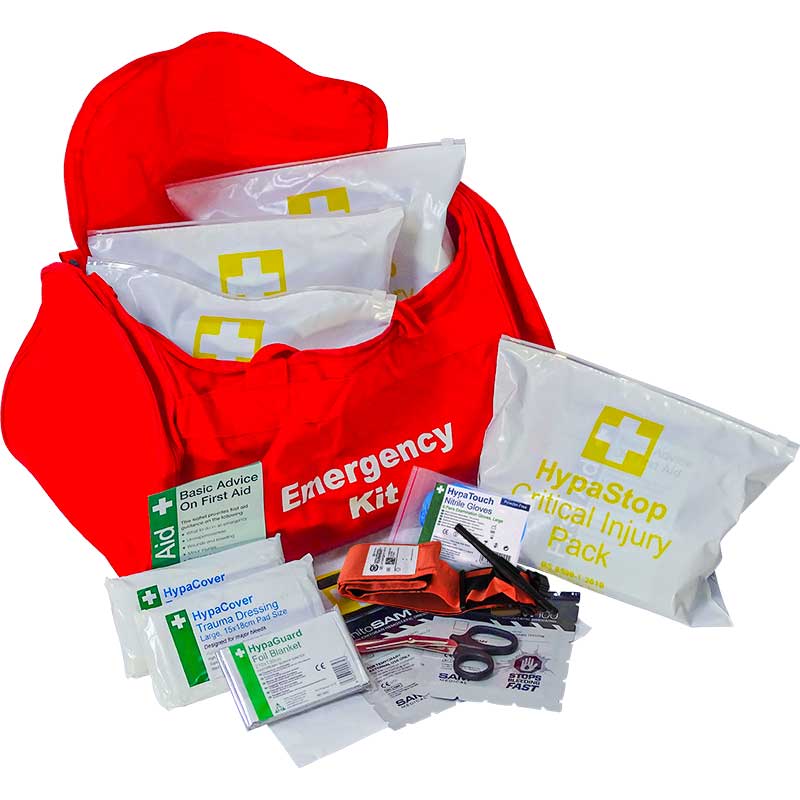 Currently, Martyn’s Law does not mandate the presence of any specific first aid kits, including trauma or PAcT kits. However, it is generally understood that for workplaces at risk of a mass casualty incident, having a trauma kit on-site would be considered a reasonable and appropriate standard of first aid preparedness. Protect UK also suggests that it is good practice to have a Public Access Trauma Kit (PAcT) readily accessible in a venue regardless of its size.
Currently, Martyn’s Law does not mandate the presence of any specific first aid kits, including trauma or PAcT kits. However, it is generally understood that for workplaces at risk of a mass casualty incident, having a trauma kit on-site would be considered a reasonable and appropriate standard of first aid preparedness. Protect UK also suggests that it is good practice to have a Public Access Trauma Kit (PAcT) readily accessible in a venue regardless of its size.Having a trauma kit ready and available for use in an emergency situation could mean the difference between life and death. They are designed specifically to treat injuries resulting in issues such as severe or life-threatening bleeding with supplies such as tourniquets and haemostatic dressings. One of the aims of Martyn’s Law is to reduce the impact a mass casualty event can have, so by providing a trauma first aid kit which could save someone’s life, a business can show that they have taken steps to reduce the risk to life.
Although Martyn’s Law does not legally require businesses to provide trauma first aid, it emphasizes the importance of having first aid supplies readily available to treat life-threatening injuries during emergency situations.
Our trauma kits
Evolution Plus Critical Injury Bleed Control Kit
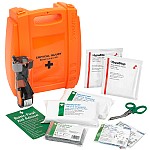
- Designed to deal with catastrophic blood loss
- Suitable for high-risk industries
- Supplied in an Evolution case
- Comes with a wall-mountable bracket
- Ideal for use alongside Martyn’s Law
Personal Trauma Kit
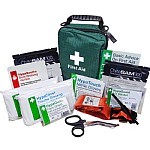
- Ideal for immediate response to traumatic events
- Two compartments to ensure items are easily found in an emergency
- Contains supplies to control severe bleeding quickly
- Discreet belt loop allows kit to be easily worn at all times
Mass Casualty Kit

- Portable shoulder bag for treating multiple serious casualties
- Suitable for anywhere there is risk of severe injury to multiple people
- Supplied in a durable zip shoulder bag
- Includes 5x BS 8599-1:2019 Critical Injury Packs
- Kit dimensions: 50cm x 28cm x 32cm
HypaStop Critical Injury Pack, Professional
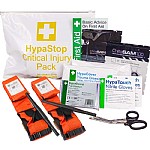
- BS 8599-1:2019 Compliant Critical Injury Pack
- Designed for use anywhere someone could suffer a severe injury
- Supplied in a portable zip bag
- Contains items to help manage catastrophic blood loss
- Kit dimensions: 24cm x 30cm
Personal Trauma Kit with Chito-SAM 100 Z-Fold Dressing
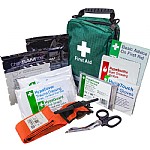
- Contains key components that help to provide immediate response at the time of a traumatic event
- Features a discreet belt loop so it can be easily worn at all times
- Chito-SAM 100 Z-Fold Haemostatic Dressing assists with the clotting of blood, therby reducing blood loss
HypaStop Critical Injury Pack, Standard
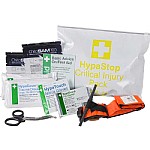
- BS 8599-1:2019 Compliant Critical Injury Pack
- Ideal for managing catastrophic blood loss
- Portable pack useful anywhere a person could suffer from a severe injury
- Suitable for industries with dangerous machinery, power tools, forestry or cutting equipment
- Pack Dimensions: 24cm x 30cm
Our trauma first aid points
Evolution First Aid and Bleed Control Point
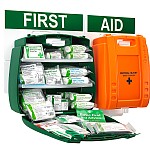
- Centralised emergency response – Stores both first aid and bleed control kits in one clearly marked, accessible location.
- Rapid deployment – Quick-release wall brackets and workbench-style case design supports fast, efficient treatment.
- Enhanced visibility – Photoluminescent headers ensure kits are easily located, even in low-light or smoke-filled conditions.
- Regulatory compliance – Supports preparedness in line with Martyn’s Law
- Ongoing readiness – “Kit missing” indicators help teams maintain fully stocked, compliant stations at all times.
Evolution First Aid, Bleed Control & Burns Point
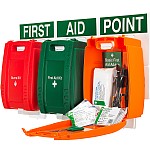
- Centralised emergency response – Stores first aid, bleed control and burns kits in one clearly marked, accessible location.
- Rapid deployment – Quick-release wall brackets and workbench-style case design supports fast, efficient treatment.
- Enhanced visibility – Photoluminescent headers ensure kits are easily located, even in low-light or smoke-filled conditions.
- Regulatory compliance – Supports preparedness in line with Martyn’s Law
- Ongoing readiness – “Kit missing” indicators help teams maintain fully stocked, compliant stations at all times.
Evacuation plans under Martyn’s Law
Martyn’s Law requires premises to have an evacuation plan and ensure staff are properly trained to respond effectively if evacuation becomes necessary.Evacuations can occur suddenly, so having a portable emergency evacuation kit stocked with first aid supplies and other essential items is highly recommended.
It is important to ensure that any evacuation kit contains supplies such as high visibility vests and wind up torches in case of low visibility and easy identification of staff and potentially perry whistles and a megaphone if there is a need for crowd management or alerting emergency services to a location.
Our Evacuation Kits
Emergency Evacuation Kit
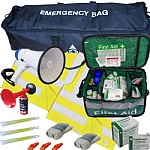
- Comprehensive package for emergencies requiring evacuation
- Suitable for response to large incidents
- Supplied in a durable and lightweight case
- Includes a full British Standard compliant first aid kit
- Contains hi vis vests, whistles, torches, foil blankets and a mini megaphone
HypaGuard Foil Blankets in Carry Holdall
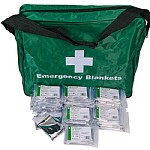
- Ideal for storing and transporting large numbers of blankets
- Keeps 100 blankets tidy and in one place for when you need them
- Ideal for mass evacuation situations
- Holdall's size: 50x43x12cm
Do staff need to be first aid trained?
Although many businesses already require at least one staff member to be trained in first aid, Martyn’s Law does not mandate first aid training. Importantly, most trauma kit equipment is designed for straightforward use, even by individuals without prior first aid experience.However, providing first aid training to venue staff is highly recommended to help them stay calm and respond effectively during emergencies. In high-stress situations, people often experience a fight-or-flight response, but trained staff are more likely to react confidently and promptly, minimising delays between the incident and the casualty receiving appropriate care.
Conclusion
Martyn’s Law primarily focuses on strengthening security measures to protect visitors in the event of a terrorist attack, but it also underscores the importance of having supplies on hand to reduce the harm if an incident occurs.Immediate access to first aid, especially to control catastrophic bleeding, can save lives by stabilising casualties until professional medical help arrives. This makes updating your trauma first aid supplies an ideal complement to implementing the new requirements under Martyn’s Law.
If you would like to learn more about our trauma range and how we can help you, we have created a PDF brochure that you can access here.
For more information, please read our other blogs.
By Sarah Mason
